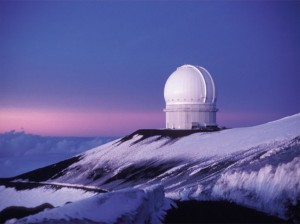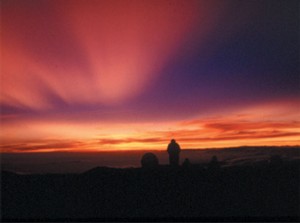Mauna Kea
by Jeanette Foster
Wright, the first licensed guide to take people up to the top of the Mauna Kea, the world’s tallest mountain when measured from the base, and an astonishing 13,796 feet when measured from the sea, fell in love with this often-snow capped peak the first time he saw it. “The ancient Hawaiians thought of the top of Mauna Kea as heaven, or at least where the Gods and Goddesses lived,” said Monte “Pat” Wright, owner and chief guide of Mauna Kea Summit Adventures. “I was a mountain guide all over the world,” he explained, “but once I saw this mountain, I could feel how special it is.”
Some 28 years ago, with a 13-year old Landcruiser and a box of old sweaters, Wright set out to share this sacred mountain with visitors, by taking them up the then-narrow, one-lane jeep trail up to the top. “Dinner was Kentucky Fried Chicken,” Wright recalled, shaking his head in laughter. The means were primitive, but his clients were enthralled. A few years later, Halley’s Comet came along and Wright, who had always been interested in astronomy, decided to add a portable telescope as part of his adventure to share the night skies, and especially the tail of the comet, with his clients. The results were overwhelming and the demands for his trips were meteoric.
Today, Mauna Kea Summit Adventures offers a much more luxurious trip, with high tech help, than those of the humble beginnings. The 7 1⁄2 -8 1⁄2 hour adventure actually begins mid-after- noon with pick up along the Kona- Kohala coast in one of their custom built 4×4, turbo-charged, micro-coach, vans. As the passengers make the drive up the mountain, the extensively- trained guides discuss the geography, geology, natural history and Hawaiian culture along the way. The first stop is the Onizuka Visitor’s Center, at the 9,000 foot level. “We let people out to stretch, get acclimatized to the altitude and to eat dinner,” Wright said. As guests gear up with Mauna Kea Summit’s heavy, arctic-style hooded parkas and gloves (30 degrees F is the average temperature on the mountain), the guide describes why the world’s largest telescopes are located on Mauna Kea and also tells stories about the lifestyle of astronomers who live for a clear, night sky. After a hearty, hot meal, everyone climbs back into the van for the half hour ride to the summit.
Arriving in time to catch the sun sinking into the Pacific nearly 14,000 feet below, the guide points out the various world renown telescopes as the obser- vatories open and the high-tech, multi- mirrored telescopes rotate into position for the night viewing. After the best of the sunset colors have faded, the tour again descends down to mid- mountain, where the climate is more agreeable for stargazing. Here’s where Mauna Kea Summit Adventures stands out above the competition. Each van has a large 11”computerized telescope, capable of 30-350x magnification that gathers up to 700x more light than the unaided eye. These high-tech telescopes guided by satellites can find objects generally more difficult to find manually (frequently they view exotic targets like the Owl Nebula or the Crab Nebula).
Wright does caution people to book the adventure early in their vacation. “Although we do cancel about 25 trips a year due to weather, we want to be able to accommodate everyone,” he said. Extensive series of live web cameras, live weather stats and a full- time meteorologist constantly feed weather information on the mountain. If guests book at the beginning of their holiday and the trip is canceled due to weather, then Mauna Kea Summit Adventures will attempt to reschedule another day, however, almost all of the tours sell out.
Wright also points out that due to the summit’s low oxygen level (40 per cent less oxygen than sea level) and the diminished air pressure (also 40 percent less air pressure than sea level), the lack of oxygen can be a serious problem for people with heart or lung problems or for scuba divers who have been diving in the previous 24 hours. Pregnant women, young children under 13 years old or severely obese people should not travel to the summit. Since the roads to the summit are bumpy, anyone with a back injury might want to reconsider the trip.
